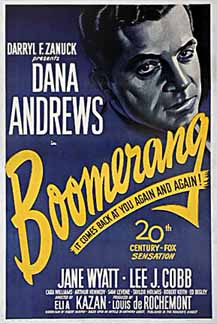Boomerang! (1947)
Directed by Elia Kazan
Screenplay by Richard Murphy, based on the article
“The Perfect Case” by Fulton Oursler
Runtime: 1 hr, 28 min
One night, a
beloved Episcopalian minister is shot on a Connecticut street. There are many witnesses, but the killer
cannot be found. Tensions run high and
the political pressures are on. This is
not a far out scenario; in fact, it actually occurred. Elia Kazan’s Boomerang! is based on the real-life murder of Bridgeport resident
Father Hubert Dahme and the ensuing search for the guilty party. What Kazan and screenwriter Richard Murphy
craft from it is a fascinating study of personal politics and society’s
instinct to immediately condemn.
After endless
days of tracing down suspects—with only “wearing a dark coat and light hat” to
work with—the police force, led by Chief Harold Robinson (Lee J. Cobb) settle
on a down-on-his-luck WWII veteran who just recently left town, John Waldron
(Arthur Kennedy). The prosecution is up
to state’s attorney Henry Harvey (Dana Andrews). All of the evidence, from the eyewitness
testimony to the forensic analysis to the suspect’s confession, seems to point
in one direction, but Harvey has his doubts regarding Waldron’s guilt.
Setting aside
that Boomerang! is grounded in actual
events, the film is filled with true-to-life drama. The citizens of the town are outraged,
forming their own committees and sending tips on anyone vaguely matching the
vague sketch. At one point a group of
the reverend’s friends are damn set on lynching Waldron as he’s brought out of
the court building. The drama is not
restricted to the everyday citizen either.
The sitting politicians are feeling the heat, and with an election
coming up, the party desperately wants a conviction.
With all this building
tension, it’s no surprise that the film’s greatest strength is how it portrays
the individual reactions to the events.
It may be useful to compare the arcs of the prosecutor and the police
chief. Andrews’ character certainly has
some political ambitions, and like anyone else in town he wants to see justice
served and the murderer apprehended.
Meanwhile, Chief Robinson, described as one stubborn goat, remains
skeptical of Waldron’s guilt, even as the evidence starts pouring into the
station.
Yet it many
ways, the changing realities of the situation causes them to switch
positions. Once the bullet has been
analyzed and found to match Waldron’s gun, Robinson’s mind is set. Harvey, though, upon his own investigations
into the crime, turns his own skeptical eye on the evidence. Both Cobb and Andrews are exquisite in their
roles, makes both of their characters’ transitions believable in the context of
the narrative. This especially shines
through in their multiple conversations; behind the chatter is an air of
frustration with each other.
It would be
obvious, though, that emotions would be running high. What Boomerang!
remembers—places at the forefront, even—is how the politics, big picture and
otherwise, are in play as well. I’d
imagine a temptation to follow the murder mystery aspect of the case all the
way down. It would work, given the
strength of the performances, but it would also give the false impression that
one man’s guilt is the sole intrigue in the case. What about the question, “What’s at stake if
we can’t convict someone?”
Ultimately, it
is this question that Kazan and Murphy focus on. Murphy writes in ample scenes of local
politicians discussing the stakes—elections are in the air, money is on the
table, ambitions and reputations could be shattered. Meanwhile, Kazan stages these encounters
beautifully, especially a late night talk between Harvey and a local backer of
a recreation center played by Ed Begley, a scene which proves pivotal to
Harvey’s character development. It’s not
just a whodunit; there’s a whole other world emerging here.
This is not to
imply that the film doesn’t have some problems.
Boomerang! is in the style of
a docudrama, with narrations supplying context and off screen goings-on. It may be too much to ask the filmmakers to
abandon an aesthetic, but the result tends to tell rather than show; we can see
they’re rounding up everyone wearing the wrong outfit without a full
explication. Also, there’s a clear
alternate suspect who Kazan spends far too much time showcasing as an alternate
suspect; one scene near the beginning of the film is enough to establish that
fact.
I nitpick,
however, as the finished work is exceedingly good. The case which inspired the film was never
solved, and while the in-story resolution is a bit more clear-cut, the
interpersonal ambiguities certainly remain.
Whose motives are suspect and whose are sincere? Does anyone have the integrity to set ambition
aside and see justice served? These
questions are answered, sure, but to answer them is not a short process. It requires soul-searching and determination,
but the truth is out there somewhere, which is what makes Boomerang! a movie well worth a watch.
Oh, and fun
fact: one of the people standing in a line-up is played by…Arthur Miller.

No comments:
Post a Comment